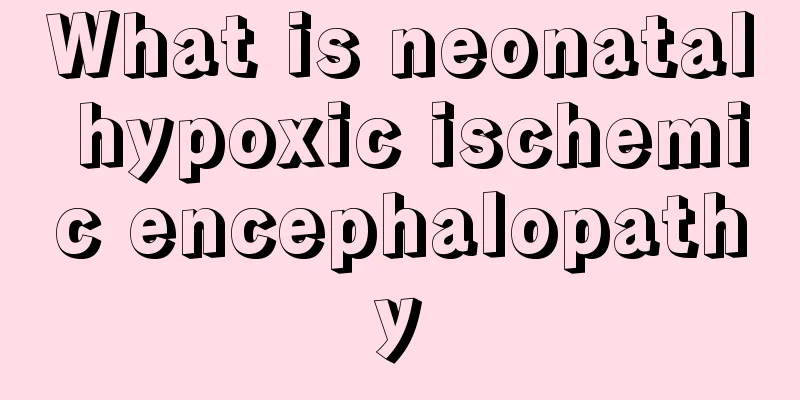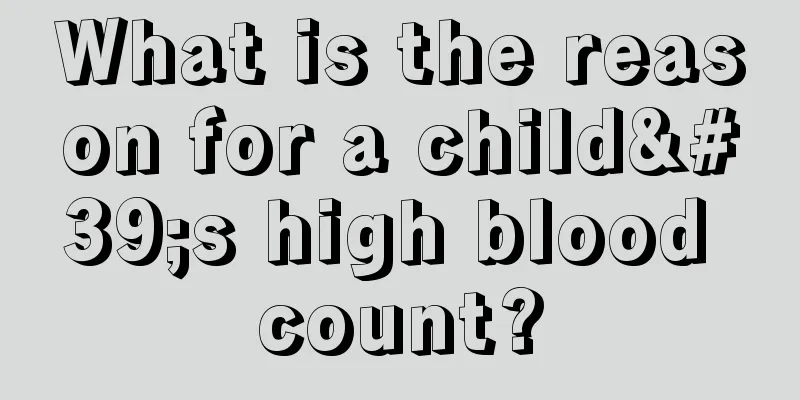What is neonatal hypoxic ischemic encephalopathy

|
What is neonatal hypoxic ischemic encephalopathy? What are the symptoms and treatments of neonatal hypoxic ischemic encephalopathy? These issues are very necessary for the families of sick children to understand. So, this article will introduce you to the relevant knowledge about neonatal hypoxic ischemic encephalopathy. Friends who want to know more about this knowledge can take a look together! Please see the detailed introduction below. Neonatal hypoxic-ischemic encephalopathy refers to hypoxic-ischemic damage to the brain caused by perinatal asphyxia. The most important clinical symptoms of this disease are consciousness state, changes in muscle tone and convulsions, which are the main indicators for distinguishing the severity of encephalopathy and its sequelae. This disease not only seriously threatens the life of newborns, but is also one of the most common causes of disability in post-neonatal children. Perinatal asphyxia is the main cause of this disease. Anything that causes obstruction of blood circulation and gas exchange between the mother and fetus, resulting in a decrease in blood oxygen concentration, can cause suffocation. Most of them are caused by intrauterine asphyxia, followed by asphyxia during delivery, and a small number are caused by congenital diseases. How to treat neonatal hypoxic ischemic encephalopathy? The purpose of treatment is to improve the metabolic function of damaged neurons as much as possible and maintain the stability of the internal environment. At the same time, special treatments such as controlling convulsions, reducing cerebral edema, and improving cerebral blood flow and brain cell metabolism should be provided. 1. General treatment ① Correct hypoxemia and hypercapnia and use artificial respirator when necessary. ②Correct hypotension. ③ Supply enough glucose to meet the energy metabolism needs of brain tissue. ④Correct metabolic acidosis. ⑤ When blood calcium is lower than 1.9mmol/L, intravenous calcium gluconate can be administered. ⑥ Appropriately limit liquid intake. 2. Control convulsions: Sodium phenobarbital is the first choice. 3. Control increased intracranial pressure: Use dexamethasone. If the intracranial pressure is still high, use mannitol instead. 4. Central nervous system stimulants, etc. Cytochrome C, adenosine triphosphate, coenzyme A, etc. can be used for daily intravenous drip until the symptoms are significantly improved; citicoline can also be diluted and given intravenously; cerebrolysin diluted with normal saline and given intravenously can improve brain tissue metabolism. Treatment must continue until the symptoms disappear completely. Moderate hypoxic-ischemic encephalopathy should be treated for 10-14 days, and severe hypoxic-ischemic encephalopathy should be treated for 14-21 days or longer. The sooner treatment is started, the better, and it should generally be started within 24 hours after birth. Try to avoid various pathological factors after birth that may aggravate brain damage. The above is an introduction to the relevant knowledge about what is neonatal hypoxic ischemic encephalopathy. I believe that after reading the introduction in this article, you will have some understanding of the relevant knowledge about neonatal hypoxic ischemic encephalopathy, and know the definition, symptoms and treatment methods of neonatal hypoxic ischemic encephalopathy. This knowledge is also very helpful for the family members of the sick children. |
<<: What to do if your newborn gets angry
>>: What is the best treatment for neonatal eczema?
Recommend
What medicine should children take to clear away heat and reduce fire
For children, clearing away heat and reducing fir...
What to do if your baby has a respiratory infection and fever
Babies have weak constitutions and will catch a c...
Why do children have big bellies?
Many children have big bellies, which seriously t...
What are the dietary treatments for children’s colds and coughs?
When children are young, their resistance is rela...
Reasons for decreased appetite in two-month-old babies
In daily life, many mothers have found that many ...
Treatment of cough after cold in children
Colds and coughs are our response to foreign viru...
How many months is it normal for babies to start growing teeth?
It takes a certain amount of time for babies to g...
Child has goose bumps due to fever
When adults have a fever, they will feel chills, ...
What are the requirements for baby silver bracelets
There has always been a folk custom of giving sil...
Treatment for night sweats in children
Children's physical health is one of the thin...
Why does a child have a fever but his body is hot but his hands and feet are cold?
Children have very low resistance and very limite...
Bird flu symptoms in children
Avian influenza is a relatively common type of in...
Severe mental retardation
The key to curing mental retardation in children ...
What vaccines should a 2-month-old baby get?
In modern life, medical scientists have invented ...
How to treat a four-year-old baby grinding his teeth at night
A four-year-old baby can already sleep by himself...









